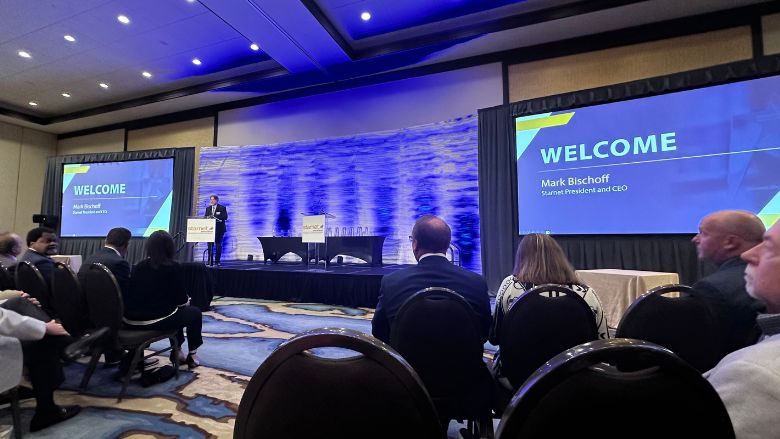Starnet Commercial Flooring Contractors Chart a Course for Growth

Starnet held its annual meeting in Amelia Island, Florida, May 16-19, 2024. Photo: Floor Trends & Installation.

Starnet President and CEO Mark Bischoff at the 2024 Starnet Annual Meeting in Amelia Island, Florida. Photo: Floor Trends & Installation.


Members of Starnet Worldwide Commercial Flooring are charting a new course for growth. At the cooperative's annual meeting held on May 16-19, 2024, in Amelia Island, Florida, the group's 171 independent contracting businesses expressed regional variations in confidence, discussed the impact of return-to-office policies, and explored the strategic use of technology and structured purchasing agreements to support members and improve sales.
The commercial flooring sector remains optimistic despite initial concerns about a recession and the downturn in discretionary spending. The U.S. economy is expected to show some weakness in 2024, a decrease of 1%, according to economist Taylor St. Germain of ITR Economics who spoke at the convention.
"We have five consecutive years of growth as we come out of 2024, so you should be thinking about 'How do I take advantage of a slower year to prepare my business for five consecutive years of growth?'" Germain said.
According to Starnet members, the Northeast and Midwest are showing more confidence, while the West Coast is lagging.
"We had a really good year last year," said Boston-based Starnet member Zach Miliano, account executive, Pavilion Floors, a Diverzify Company. "We did a great job—we retained a specific client and gained repeat business, and we've got another two health systems on board that are following the exact same model that we did with the first."
The office market remains weak, particularly in negotiated office work, which involves shorter cycles related to lease renewals and moving tenants. Commercial flooring contractors traditionally relied on this business to maintain steady cash flow.
In Portland, Oregon, the downtown vacancy rate is around 40%. "Needless to say, that's not a segment we're focusing on," said Eric Munson, district manager Oregon, Mannington Commercial. "We're shifting focus to other segments and figuring out how to capitalize on our partnership and on the business that's out there."
"We're very customer focused, meaning you can't just sit back and hope that business comes to you," said Starnet member Jason Beam, account manager, Floor Solutions LLC, in Portland. "You've got to be patient. It's a bit of a marathon."
Long-cycle projects that began before the pandemic are still progressing, particularly in New York.
"In New York City, if someone moves something, it costs a fortune," said Starnet President and CEO Mark Bischoff. "It's likely that these are significant projects that have already been budgeted."
Several major corporations, such as Goldman Sachs, Walmart, Amazon and IBM, are enforcing return-to-office policies—a trend that could improve future office business. "At some point, if the earnings don't support working from home, if you're a certain kind of business that has to be innovative and have teams, you're going to be in the office," Bischoff said.
To help members boost cash flow, Bischoff said that Starnet is emphasizing structured purchasing agreements. These agreements streamline purchasing for entities like schools, government agencies and healthcare entities, bypassing the traditional bid process and mitigating risk while ensuring compliance with ethical requirements.
"You use the tool of a structured purchasing agreement to teach end users how to buy floor covering on the agreement," Bischoff explained. "They're already buying copy machines, bedsheets, gowns, sutures and hypodermic needles, but we're helping our members teach end users how to install floor covering on these purchase agreements. If you're a federal, state, local government employee, it allows you to get the outcome you want without the bid process but still follow all of the ethical requirements of a purchase so that people don't get in trouble for not bidding work."
Technology continues to be an innovation point for Starnet. Commercial contractors are shifting towards the use of visualizers to enhance the sales process, enabling quicker decisions by showing potential outcomes directly on-site via mobile devices. This approach is designed to improve timelines and cash flow.
"That's new for our people because they're used to prints, folders, chips—it's totally different," Bischoff said. "It's a struggle because it's a behavior change, but the old ways created too many touch points, which created no decision. The worst thing in our business is no decision."
Flooring manufacturers, software providers and commercial flooring contractors are also using technology to increase collaboration and streamline processes. One significant improvement is the standardization of product codes. Previously, entering new product codes was cumbersome, leading to inconsistencies and errors. Now, manufacturers provide standardized codes directly to software, which reduces errors and efficiencies, Bischoff said.
Another example of technology at work: Starnet contractors are increasingly using bots and artificial intelligence (AI) to improve efficiency and decision-making. Bots quickly scan and summarize lengthy documents, identifying key terms and phrases. This helps members decide whether a job is worth pursuing without manually reviewing the entire document.
Bischoff said that next step is to increase the use of predictive analysis using AI. AI can analyze and identify patterns in bid data that might not be immediately obvious. For example, AI can determine the likelihood of winning a job based on variables such as the general contractor (GC), end user, manufacturer and legal language. It's a new world for business owners who might have traditionally relied on their instincts to make these business decisions.
"What we've told them is even if you say it's not good in your business, who's going to use it against you?" Bischoff said. "Who's going to use it to beat you every day, and you won't even know what happened?"
Lastly, Starnet is encouraging its members to structure their businesses to scale. With the traditional cradle-to-grave sales process, the salesperson meets the customer, estimates the job, orders the materials, runs the job and chases for payment upon completion. An alternative business structure is a siloed structure where estimators only estimate and salespeople only develop business. A project is handed to the management team, which manages and runs the job, and the finance people chase the money.
"If you're able to silo, the salespeople can chase work both negotiated and bid and raise the top-line capacity for themselves," Bischoff said. "Many of our members haven't moved there because it requires a lot more overhead. But with the overhead that comes is the ability to scale the top line of your business because now a salesperson, instead of selling $3 million, they might be selling $7 or $8 or $10 million."
Looking for a reprint of this article?
From high-res PDFs to custom plaques, order your copy today!









